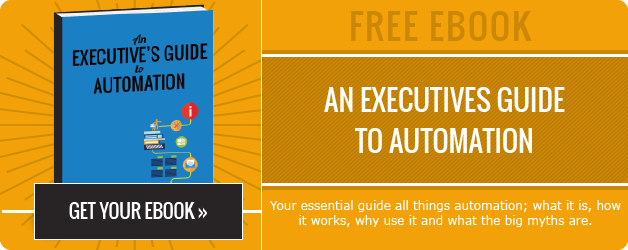We work with people who do jobs that span almost every business field - Marketing, Customer Support, Finance, Project Management, Stock Management, Deliveries and Engineers (to name a few) - and software is changing all of these. How? By innovating processes.
It’s important to note here though, that it’s not us (the Software Engineers) driving this revolution - it’s you. The Marketers, Financiers, Project Managers etc. You are simply looking for a better, easier, more effective way to do your jobs - and software holds the key.
To be clear, this is not in 2 or 5 or 10 years time folks, it’s happening right now. We work with people like you EVERY SINGLE DAY.
And who are the successful ones? It’s the people who have an understanding of how software works AND a mindset that allows them to apply this understanding to their specific challenges.
These are normal, everyday people who have a creative mind and the understanding of the tools available to make a difference.
To begin to uncover this creative and software-centric side of yourself, here are 8 things you need to know about software.
1. The first step to success is understanding your business (or department)
In order to be effective you need to have an understanding of 3 things:- Your processes and pain points
- Your future goals
- An idea of what software (in general) is capable of
You can’t run a mid-sized business on Pastel anymore. Your business needs more than that. More responsiveness (especially to those overnight changes in customer perceptions and needs), more flexibility, more...connected-ness. And understanding your business (or department), its needs, and what is required to fulfil your goals is essential in driving that success.
2. Software no longer ‘belongs’ to the IT Department
No more dark corridors leading to terrifyingly technical departments headed up by wizards - software is easy to use and totally relatable. You're probably already utilising more automation that you think. Google Calendar? Gmail?
Software is an integral part of your business operations - from Marketing Automation, Mobile Apps, Lead Generation, Provisioning, Billing and Collections to Customer Self-Service.
Software belongs to those who use it. And the more you understand how best to use it, the more use you’ll make OF it.
3. There is always a better way to do something
As Jim Rohn said, "If you don't like where you are, move. You are not a tree." If you don’t like how things are done, and you can see a better way to do it - then do it.
For almost every operationally stunting process, there is a better way to do things. And it almost always involves automating tasks using software. Think your recruitment process is clunky? Streamline it by enabling online testing/pre-screening. Think your lead capture process isn’t responsive enough? Bring intelligence to it.
The point is that there are creative and innovative ways to solve these seemingly unsolvable problems, and sometimes the solution is as easy as connecting 2 pieces of software with Zapier, or using Gmail Canned Responses. Get imaginative, get innovative.
4. Responsiveness is everything
We’ve all been told for years that ‘business is changing’ - well, it’s changed. And it continues to change at a breakneck pace. Being successful isn’t about being ahead of the curve, it’s about being able to respond to those changes, quickly.
It’s about creating a responsive business in an Internet Era, and to do that business people need to understand software. As explained in our recent blog post, “3 Things Your Business Needs To Operate At Internet Speed”, software that enables scalability is key to businesses wishing to operate at Internet Speed.
In order to best leverage software that enables scalability, businesses need to:
- Foster a culture of continuous improvement in every department.
- Understand that scalability is no longer limited by geography, but by efficiency.
- Embrace the idea of software as a fundamental aspect of your business operations.
You don’t have a static business, so why would you invest in static software, and understanding growth-driven software is a big part of that.
5. Not all software is created equal
As with pizza, some software is good, and some software is bad. Do your research online, ask around, test things out. Find out what works, and, more importantly, what works FOR YOU. The best development companies won’t have anything to hide - they’ll conduct extensive demos and work with you in workshops to understand your requirements and show you how their software can aid in your business objectives.
You might try 2 or 3 different Project Management tools until you find the one that’s right for you. Use free trials and/or demo’s - that’s what they are there for.
The bottom line here is - don’t be afraid to experiment. If something doesn’t work, don’t walk away from the idea. Keep looking and testing out things until you find something that fits you.
6. Software development is iterative
Rome, as they say, wasn’t built in a day. Even the biggest platforms like Google continually release updates, changes and evolutions of their software.
This is what Google looked like on the day it launched: [source]

The best software, and more importantly, the best business software is growth driven. I.e. it continues to grow and evolve based on changes in the market, technological advancements and learning curves.
This is also worth keeping in mind when embarking upon a software project, especially if your chosen solution is being customised towards your particular business preferences. Working with a successful Development Team will be an iterative process. This means that the design will evolve as the project nears completion. You’ll be involved in the changes made during those iterations, and those iterations will be based on your unique understanding of what works best for you business. Get involved, own the process - that’s what ensures a successful project.
7. Culture is always the key to success
Company culture should be designed to motivate your team to succeed. It directly (and indirectly) determines a number of factors within your organisation. For example, if you value innovation, then support mechanisms and operational flows are in place to encourage that innovation. If you value other characteristics, your organisation will be structured to foster those.
The bottom line: If a change in technology places enough pressure on one department such that they, or the technology, might fail - you probably need to review your company culture.
Eric Schmidt and Jonathan Rosenberg of Google, define the idea of 'smart creatives'. These are individuals within your business "who combine technical knowledge, business expertise and creativity". They explain that when you give these people today’s technology, and then, most importantly, give them space to work their magic, they can do "amazing things, amazingly fast".
In order to succeed in a world where responsiveness is everything, you need to continually encourage the development of ‘smart creatives’, or better yet, empower yourself to be one of those smart creatives. To make sure that this is even possible - a culture that supports creativity and technology is essential.
8. Understand that software is capable of anything
Absolutely anything.
Need a steaming cup of coffee ready for you at 6am? Software - simply program your coffee machine to deliver. Need to automate your Collections process? Software. Need to get a camera on Mars? Software. (yeah yeah, and jet fuel etc). But you see my point right?
The more deeply you understand software’s capabilities, the more readily you’ll turn to it to solve everyday problems. And the more readily you embrace software, the more effective you’ll become.
For example - I HATE grocery shopping. I hate having to think about food, planning ahead sucks and shopping lists are the worst. It’s a vicious cycle of having to cook dinner, but there’s never anything in the cupboard, so therefore it’s harder to cook dinner. For me, the solution was to add a series of regularly used recipes into an app that automatically creates a shopping list out of the meals I have chosen (drag-and-drop style) to cook for the next few nights. And bingo, grocery shopping is now easier, so it’s easier for me to cook. (The app is called ‘Plan to Eat’ btw). Software provided the solution, and because I’m comfortable using it, cooking dinner is now a breeze (except for the whole ‘cooking’ thing, but yeah... I’m working on that one).
You get my point though.
The bottom line is that, in a world where business (and staff) need to be hyper-responsive to changes, we need to embrace software to remain flexible and scalable.
Image Credit: Freepik








Comment